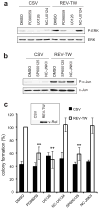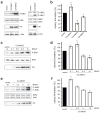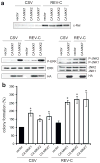ERK and JNK activation is essential for oncogenic transformation by v-Rel
- PMID: 20802521
- PMCID: PMC2992084
- DOI: 10.1038/onc.2010.359
ERK and JNK activation is essential for oncogenic transformation by v-Rel
Abstract
v-Rel is the acutely oncogenic member of the NF-κB family of transcription factors. Infection with retroviruses expressing v-Rel rapidly induces fatal lymphomas in birds and transforms primary lymphocytes and fibroblasts in vitro. We have previously shown that AP-1 transcriptional activity contributes to v-Rel-mediated transformation. Although v-Rel increases the expression of these factors, their activity may also be induced through phosphorylation by the mitogen-activated protein kinases (MAPKs). The expression of v-Rel results in the strong and sustained activation of the ERK and JNK MAPK pathways. This induction is critical for the v-Rel-transformed phenotype, as suppression of MAPK activity with chemical inhibitors or small interfering RNA severely impairs colony formation of v-Rel-transformed lymphoid cell lines. However, signaling must be maintained within an optimal range in these cells, as strong additional activation of either pathway beyond the levels induced by v-Rel through the expression of constitutively active MAPK proteins attenuates the transformed phenotype. MAPK signaling also has an important role in the initial transformation of primary spleen cells by v-Rel, although distinct requirements for MAPK activity at different stages of v-Rel-mediated transformation were identified. We also show that the ability of v-Rel to induce MAPK signaling more strongly than c-Rel contributes to its greater oncogenicity.
Conflict of interest statement
The authors declare no conflict of interest.
Figures







Similar articles
-
Cell transformation by v-Rel reveals distinct roles of AP-1 family members in Rel/NF-kappaB oncogenesis.Oncogene. 2010 Sep 2;29(35):4925-37. doi: 10.1038/onc.2010.239. Epub 2010 Jun 21. Oncogene. 2010. PMID: 20562914 Free PMC article.
-
CAPERalpha is a novel Rel-TAD-interacting factor that inhibits lymphocyte transformation by the potent Rel/NF-kappaB oncoprotein v-Rel.J Virol. 2008 Nov;82(21):10792-802. doi: 10.1128/JVI.00903-08. Epub 2008 Aug 27. J Virol. 2008. PMID: 18753212 Free PMC article.
-
LMP1 signaling and activation of NF-kappaB in LMP1 transgenic mice.Oncogene. 2006 Jan 12;25(2):288-97. doi: 10.1038/sj.onc.1209023. Oncogene. 2006. PMID: 16247482
-
The mitogen-activated protein kinome from Anopheles gambiae: identification, phylogeny and functional characterization of the ERK, JNK and p38 MAP kinases.BMC Genomics. 2011 Nov 23;12:574. doi: 10.1186/1471-2164-12-574. BMC Genomics. 2011. PMID: 22111877 Free PMC article.
-
Reactive oxygen species in the activation of MAP kinases.Methods Enzymol. 2013;528:27-48. doi: 10.1016/B978-0-12-405881-1.00002-1. Methods Enzymol. 2013. PMID: 23849857 Review.
Cited by
-
Progress in Delivery of siRNA-Based Therapeutics Employing Nano-Vehicles for Treatment of Prostate Cancer.Bioengineering (Basel). 2020 Aug 10;7(3):91. doi: 10.3390/bioengineering7030091. Bioengineering (Basel). 2020. PMID: 32784981 Free PMC article. Review.
-
Characterization of ATF2 in Rel/NFκB oncogenesis reveals its role in the regulation of Ras signaling.Small GTPases. 2011 Mar;2(2):89-94. doi: 10.4161/sgtp.2.2.15310. Small GTPases. 2011. PMID: 21776408 Free PMC article.
-
Differential effect of grape seed extract against human non-small-cell lung cancer cells: the role of reactive oxygen species and apoptosis induction.Nutr Cancer. 2013;65 Suppl 1(0 1):44-53. doi: 10.1080/01635581.2013.785003. Nutr Cancer. 2013. PMID: 23682782 Free PMC article.
References
-
- Basseres DS, Baldwin AS. Nuclear factor- B and inhibitor of B kinase pathways in oncogenic initiation and progression. Oncogene. 2006;25:6817–30. - PubMed
-
- Blume-Jensen P, Hunter T. Oncogenic kinase signalling. Nature. 2001;411:355–65. - PubMed
-
- Bonizzi G, Karin M. The two NF- B activation pathways and their role in innate and adaptive immunity. Trends Immunol. 2004;25:280–8. - PubMed
Publication types
MeSH terms
Substances
Grants and funding
LinkOut - more resources
Full Text Sources
Research Materials
Miscellaneous

